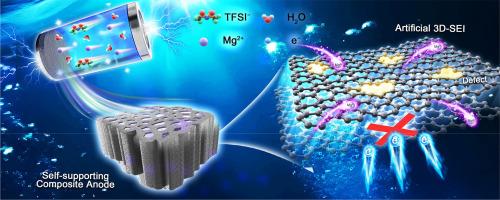可充电金属镁电池用木质硬碳自支撑三维网状复合阳极
IF 13.8
1区 材料科学
Q1 METALLURGY & METALLURGICAL ENGINEERING
引用次数: 0
摘要
可充电金属镁电池有望成为锂电池的潜在替代品。然而,在镁(Mg)表面形成通过层的外来电解质成分通常会导致可逆镁化学的超高过电位。本文构建了一种新型的自支撑复合材料来解决这一问题,该复合材料使用化学活化的天然枣木衍生的硬碳(a- jhc)作为人工镁离子(Mg2+)传导的介相,具有三维(3D)网络骨架,实现了Mg2+的选择性传输。与传统的人工固体电解质界面(SEI)不同,多孔a- jhc允许3D离子传导,从而提高离子传输效率。同时,a- jhc的界面特性抑制了Mg沉积物侵入微孔分离器,允许在界面下进行Mg的镀/剥离反应。低电子导电性的人工界面显著地稳定了传统有机电解质中的Mg电极。我们展示了这一概念验证,使含水的Mg||V2O5全电池的可逆循环成为可能,也为以前被认为与Mg不相容的电解质打开了大门。本文章由计算机程序翻译,如有差异,请以英文原文为准。

Self-supporting composite anodes with three-dimensional network by wood-derived hard carbon in rechargeable metallic magnesium batteries
Rechargeable metallic magnesium batteries (RMBs) are expected to be a potential replacement for lithium counterparts. Yet, exotic electrolyte components forming passing layers on magnesium (Mg) surfaces usually leads to ultrahigh overpotential for reversible Mg chemistry. Here a novel self-supporting composite was constructed to address this issue by using chemically activated natural jujube wood-derived hard carbons (a-JHCs) with a three-dimensional (3D) network like skeleton as the artificial Mg-ions (Mg2+)-conducting interphase, achieving selective Mg2+ transport. Different from the traditional artificial solid-electrolyte interphase (SEI), the porous a-JHCs allows for 3D ion-conduction, thereby improving ion transport efficiency. Meanwhile, interfacial characteristics of a-JHCs have been demonstrated to suppress the intrusion of Mg deposits into micro-porous separators, allowing the Mg plating/stripping reaction beneath the interface. The artificial interface with low electronic conductivity significantly stabilizes the Mg electrode in conventional organic electrolytes. We show this proof-of-concept enables the reversible cycling of a Mg||V2O5 full-cell in the water-containing, and also opens the door to electrolytes previously considered as non-compatible with Mg.
求助全文
通过发布文献求助,成功后即可免费获取论文全文。
去求助
来源期刊

Journal of Magnesium and Alloys
Engineering-Mechanics of Materials
CiteScore
20.20
自引率
14.80%
发文量
52
审稿时长
59 days
期刊介绍:
The Journal of Magnesium and Alloys serves as a global platform for both theoretical and experimental studies in magnesium science and engineering. It welcomes submissions investigating various scientific and engineering factors impacting the metallurgy, processing, microstructure, properties, and applications of magnesium and alloys. The journal covers all aspects of magnesium and alloy research, including raw materials, alloy casting, extrusion and deformation, corrosion and surface treatment, joining and machining, simulation and modeling, microstructure evolution and mechanical properties, new alloy development, magnesium-based composites, bio-materials and energy materials, applications, and recycling.
 求助内容:
求助内容: 应助结果提醒方式:
应助结果提醒方式:


